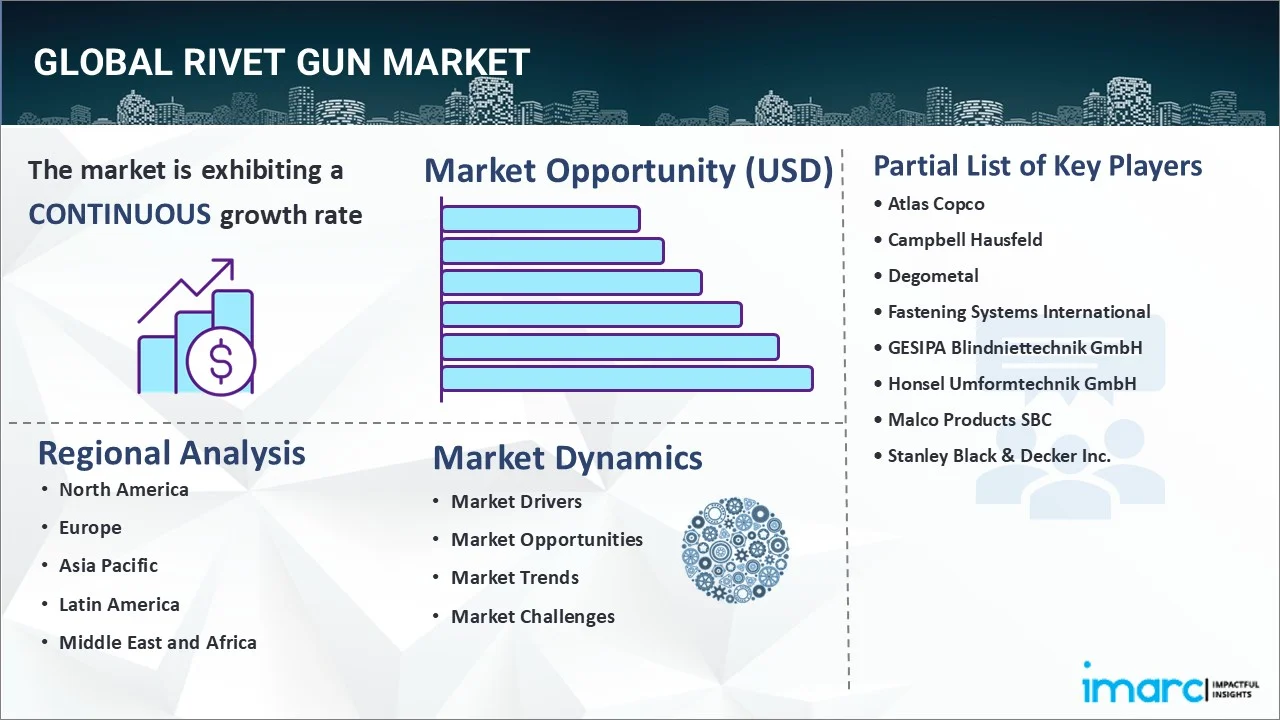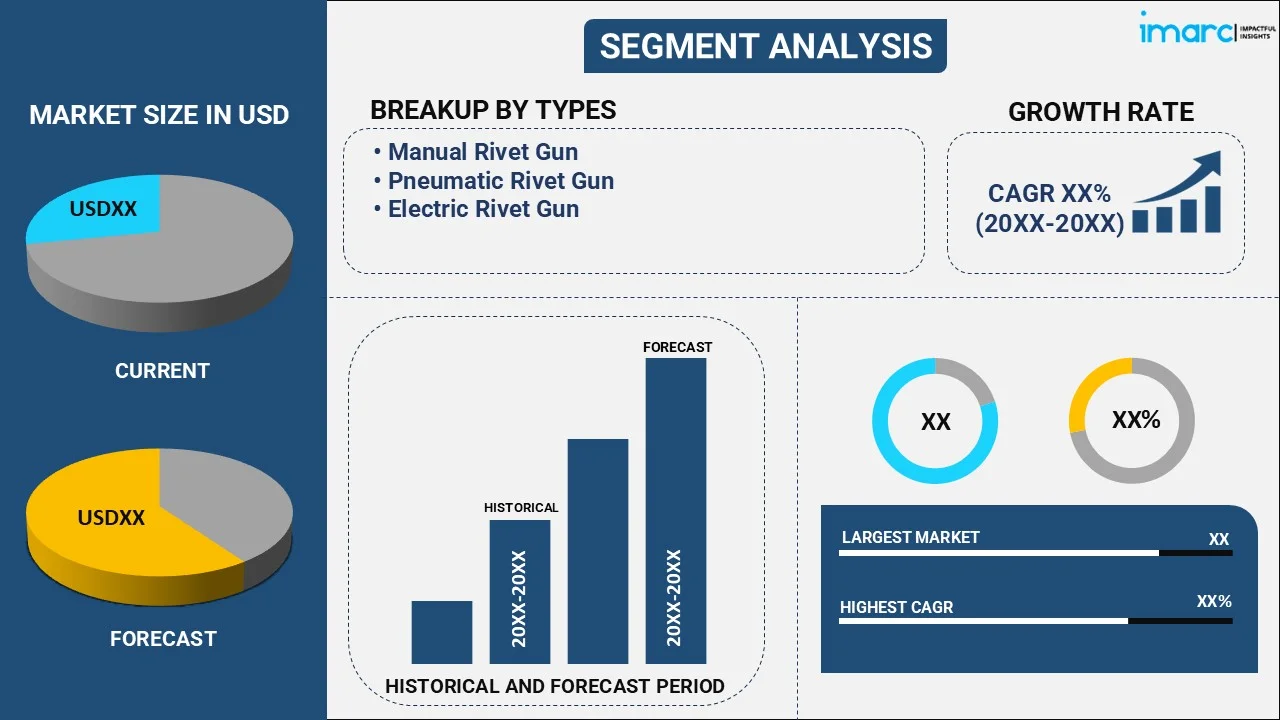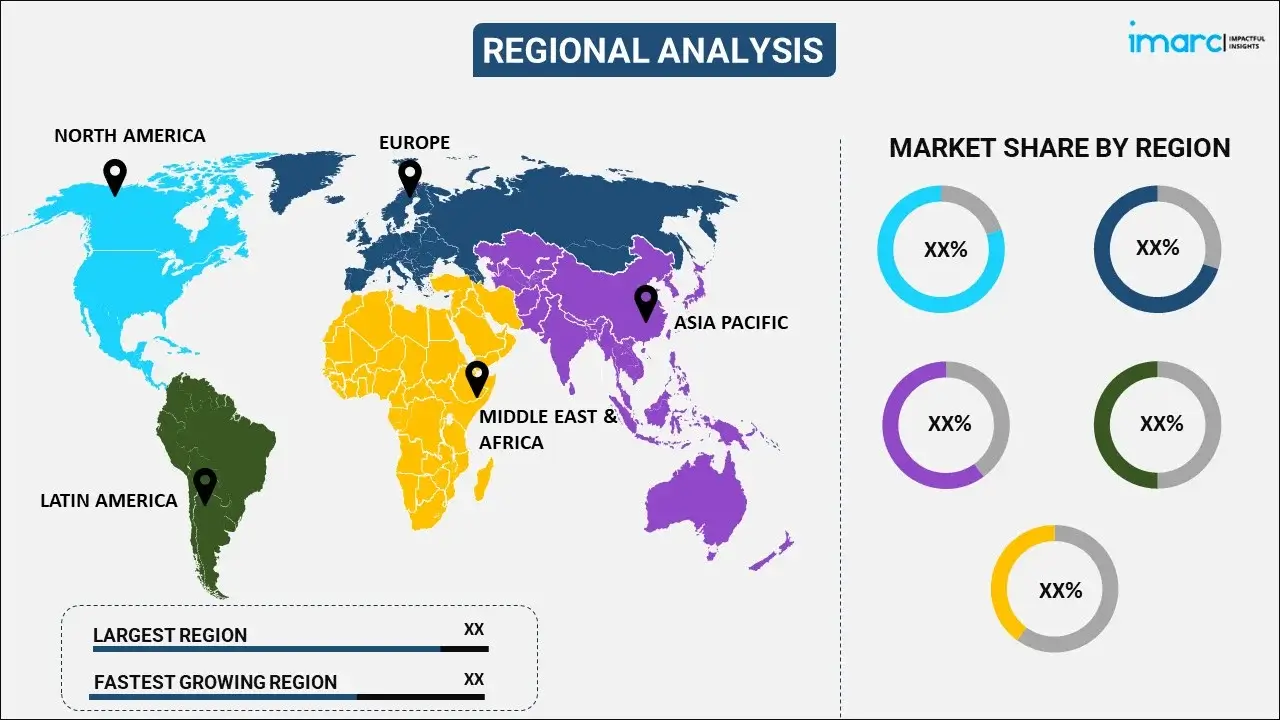
Rivet Gun Market Report by Type (Manual Rivet Gun, Pneumatic Rivet Gun, Electric Rivet Gun), Operation Type (Pop Riveting, Slow Hitting, Fast Hitting), Distribution Channel (Online Sales, Offline Sales), Industry Vertical (Automotive, Manufacturing, Maintenance and Repairs, Electronics, and Others), and Region 2025-2033
Market Overview:
The global rivet gun market size reached USD 618.2 Million in 2024. Looking forward, IMARC Group expects the market to reach USD 976.7 Million by 2033, exhibiting a growth rate (CAGR) of 5.21% during 2025-2033. The increasing preference for lightweight variants in numerous industry verticals, rising need for remodeling and upgradation of homes, and the growing use of smartphones, laptops, and microwaves are some of the major factors propelling the market.
|
Report Attribute
|
Key Statistics
|
|---|---|
|
Base Year
|
2024 |
|
Forecast Years
|
2025-2033
|
|
Historical Years
|
2019-2024
|
| Market Size in 2024 | USD 618.2 Million |
| Market Forecast in 2033 | USD 976.7 Million |
| Market Growth Rate (2025-2033) | 5.21% |
A rivet gun is a handheld tool used in construction, manufacturing, and automotive industries to fasten materials using rivets. It is produced using durable materials, such as steel or aluminum alloy, for its body, which ensures longevity and strength. It offers speed, reliability, and the ability to create strong, permanent connections. It does not require heat or electricity, which makes it suitable for different environments. It provides robust connections that withstand mechanical stress and vibrations.

The increasing preference for lightweight designs in numerous industry verticals for improved efficiency is driving the demand for rivet guns to facilitate the assembly of lightweight materials around the world. Moreover, the rising need for remodeling and upgradation activities of homes is favoring the growth of the market. In addition, there is an increase in the use of smartphones, laptops, coffee makers, grillers, toasters, microwaves, gaming consoles, computers, and smart wearables. This, along with the emerging trend of miniaturization of electronics, is contributing to the market growth. Apart from this, the growing adoption of renewable energy is catalyzing the demand for rivet guns to assemble components in solar panels and wind turbines. Furthermore, the increasing production of medical devices and equipment is strengthening the growth of the market.
Rivet Gun Market Trends/Drivers:
Increase in efficiency and precision
There is a rise in the demand for rivet guns across the globe on account of their efficient and precise nature in fastening materials. These tools streamline assembly processes by rapidly securing rivets, reducing manual effort and time. Their ability to consistently apply the correct pressure and ensure uniform rivet installation enhances product integrity. As industries increasingly focus on production optimization, rivet guns stand out for their ability to ensure strong and reliable connections without the need for extensive skill. This efficiency not only enhances productivity but also reduces labor costs, making rivet guns an essential tool in various manufacturing sectors.
Rise in reliability and durability
The reliability and durability of rivet connections is driving the demand for rivet guns as they create strong, permanent bonds that withstand various stresses, such as vibrations and changes in temperature. This reliability is crucial in industries wherein safety and product integrity are paramount. Unlike fasteners that can loosen over time, rivet connections remain steadfast, contributing to the longevity of products. This assurance of long-lasting performance elevates the appeal of rivet guns, especially in applications wherein failure is not an option.
Growing demand for safety and ergonomic design
Safety considerations in workplaces have heightened the demand for rivet guns. These tools are designed with ergonomic features that reduce operator fatigue and strain during extended use. Enhanced safety mechanisms prevent accidental firing, reducing the risk of injuries. As businesses prioritize employee well-being and adhere to stringent safety regulations, the ergonomic design and safety features of rivet guns align with these objectives. Moreover, the controlled process of rivet installation mitigates the hazards associated with other fastening methods that involve heat or sparks. This emphasis on safety and ergonomic design amplifies the demand for rivet guns as a reliable and responsible assembly solution.
Rivet Gun Industry Segmentation:
IMARC Group provides an analysis of the key trends in each segment of the global rivet gun market report, along with forecasts at the global, regional, and country levels for 2025-2033. Our report has categorized the market based on type, operation type, distribution channel, and industry vertical.
Breakup by Type:

- Manual Rivet Gun
- Pneumatic Rivet Gun
- Electric Rivet Gun
Pneumatic rivet gun dominates the market
The report has provided a detailed breakup and analysis of the market based on the type. This includes manual rivet gun, pneumatic rivet gun, and electric rivet gun. According to the report, pneumatic rivet gun represented the largest segment. A pneumatic rivet gun operates using compressed air. It features an air-powered piston mechanism that drives the rivet into place when the trigger is pulled. It is faster and more powerful than manual ones, which makes them suitable for heavy-duty industrial applications. It is commonly used in manufacturing settings, such as automotive assembly lines and construction projects, wherein a higher volume of riveting is required.
A manual rivet gun is a handheld tool that operates using human force. It requires the user to press the handle to activate the tool. It is simple, portable, and suitable for smaller-scale projects or situations wherein power sources are not available. It is commonly used in DIY projects, crafts, and light industrial applications.
An electric rivet gun runs on electricity and is equipped with a motorized mechanism. It usually has a trigger or button that, when pressed, activates the motor to set the rivet. It is often more convenient and less physically demanding to use compared to manual or pneumatic options. It is useful for tasks that require repetitive riveting and provide consistent pressure for accurate results. It is commonly used in workshops, fabrication shops, and assembly lines.
Breakup by Operation Type:
- Pop Riveting
- Slow Hitting
- Fast Hitting
A detailed breakup and analysis of the market based on the operation type has also been provided in the report. This includes pop riveting, slow hitting, and fast hitting.
Pop riveting, also known as blind riveting, is a fast and efficient method of joining materials wherein access is limited to only one side. In pop riveting, a rivet is inserted into a pre-drilled hole in the materials to be joined. It is commonly used for applications wherein a watertight seal or a tidy appearance is important, such as in aircraft, automotive, and sheet metal work.
Slow hitting, also known as low-impact riveting, is a controlled method used to set rivets with precision. Its controlled impact reduces the chances of damaging delicate materials or causing surface imperfections. It is often used in situations wherein careful attention is needed, such as when working with thin or sensitive materials like electronics components or decorative items.
Fast hitting, also known as high-impact riveting, is used when speed and efficiency are of utmost importance. Fast hitting is particularly suitable for heavy-duty applications, where the priority is to join materials quickly and securely without compromising strength. It is commonly employed in industries like construction, shipbuilding, and large-scale manufacturing.
Breakup by Distribution Channel:
- Online Sales
- Offline Sales
The report has provided a detailed breakup and analysis of the market based on the distribution channel. This includes online sales and offline sales.
Online sales refer to the distribution of rivet guns through internet-based platforms and e-commerce websites. They allow customers to browse, compare, and purchase rivet guns from the comfort of their homes or workplaces. Manufacturers and retailers often have their own official websites wherein customers can place orders. Additionally, rivet guns are commonly sold through popular online marketplaces and specialized industrial supply websites. Online sales provide a wide reach, easy accessibility, and the convenience of browsing a variety of options and prices.
Offline sales involve the distribution of rivet guns through physical retail locations such as hardware stores, industrial supply shops, and tool retailers. Customers can visit these brick-and-mortar stores to see, touch, and test the products before making a purchase. These stores may have knowledgeable staff who can provide guidance and recommendations based on the needs of the customers. Offline sales also include distribution through trade shows, exhibitions, and industrial events, where manufacturers and distributors showcase their products to a targeted audience.
Breakup by Industry Vertical:
- Automotive
- Manufacturing
- Maintenance and Repairs
- Electronics
- Others
A detailed breakup and analysis of the market based on the industry vertical has also been provided in the report. This includes automotive, manufacturing, maintenance and repairs, electronics, and others.
In the automotive industry, rivet guns play a crucial role in assembling various components of vehicles. They are used to fasten parts, such as body panels, interior trim, and structural components. They are valued for their ability to provide strong and secure connections that withstand vibrations and stress. Additionally, they are used for repairs and maintenance of automobiles, helping to restore damaged parts to their original condition.
Rivet guns find extensive use in manufacturing industries, including aerospace, appliances, and heavy machinery. They are employed in the assembly of parts and components that require a permanent and robust connection. Riveting is often preferred over welding or adhesive bonding for its simplicity and reliability. Manufacturers use rivet guns to create strong joints in metal, plastic, and composite materials, ensuring the durability and safety of the final products.
Rivet guns are indispensable tools in the maintenance and repair sectors. They are used to replace or fix rivets in various applications, including construction equipment, appliances, furniture, and more. Maintenance professionals rely on rivet guns to repair broken or worn-out components swiftly and effectively, thereby extending the lifespan of products without needing to replace entire parts.
In the electronics industry, particularly for consumer electronics and small devices, rivet guns are used for intricate and delicate assembly tasks. These guns are employed to securely fasten components, connectors, and small parts in electronic devices without causing damage. The controlled application of rivets ensures that the sensitive electronic components remain intact while forming reliable connections.
Breakup by Region:

- North America
- United States
- Canada
- Europe
- Germany
- France
- United Kingdom
- Italy
- Spain
- Others
- Asia Pacific
- China
- Japan
- India
- South Korea
- Australia
- Indonesia
- Others
- Latin America
- Brazil
- Mexico
- Others
- Middle East and Africa
Asia Pacific exhibits a clear dominance, accounting for the largest rivet gun market share
The report has also provided a comprehensive analysis of all the major regional markets, which include North America (the United States and Canada); Europe (Germany, France, the United Kingdom, Italy, Spain, and others); Asia Pacific (China, Japan, India, South Korea, Australia, Indonesia, and others); Latin America (Brazil, Mexico, and others); and the Middle East and Africa. According to the report, Asia Pacific accounted for the largest market share.
The increasing demand for consumer electronics, such as smartphones or laptops, represents one of the primary factors driving the demand for rivet guns in the Asia Pacific region. Moreover, the rising upgradation activities in residential and commercial spaces is contributing to the market growth in the region. Besides this, the growing repair and maintenance of vehicles is influencing the market positively in the region.
North America is estimated to witness stable growth, owing to the growing investments in research and development (R&D) activities, product innovations, integration of advanced technologies, etc.
Competitive Landscape:
The leading companies are introducing rivet guns equipped with automatic feed systems that supply rivets without manual intervention and improves the efficiency of riveting processes, especially in high-volume manufacturing. They are also integrating robotic systems for precise and repeatable riveting tasks and to improve efficiency, reduce labor costs, and ensure uniform results. Moreover, product manufacturers are incorporating augmented reality and sensors in rivet guns to guide operators during the riveting process. Instructions and visual cues projected onto the workspace through AR glasses or devices can enhance accuracy and reduce training time. These advancements also help detect variables like material thickness, rivet integrity, and joint tightness and provide real-time feedback to the operator, which enhances the quality of riveting and prevents errors.
The report has provided a comprehensive analysis of the competitive landscape in the market. Detailed profiles of all major companies have also been provided. Some of the key players in the market include:
- Atlas Copco
- Campbell Hausfeld
- Degometal
- Fastening Systems International
- GESIPA Blindniettechnik GmbH
- Honsel Umformtechnik GmbH
- Malco Products SBC
- Stanley Black & Decker Inc.
Rivet Gun Market Report Scope:
| Report Features | Details |
|---|---|
| Base Year of the Analysis | 2024 |
| Historical Period | 2019-2024 |
| Forecast Period | 2025-2033 |
| Units | Million USD |
| Scope of the Report | Exploration of Historical and Forecast Trends, Industry Catalysts and Challenges, Segment-Wise Historical and Predictive Market Assessment:
|
| Types Covered | Manual Rivet Gun, Pneumatic Rivet Gun, Electric Rivet Gun |
| Operation Types Covered | Pop Riveting, Slow Hitting, Fast Hitting |
| Distribution Channels Covered | Online Sales, Offline Sales |
| Industry Verticals Covered | Automotive, Manufacturing, Maintenance and Repairs, Electronics, Others |
| Regions Covered | North America, Europe, Asia Pacific, Latin America, Middle East and Africa |
| Countries Covered | United States, Canada, Germany, France, United Kingdom, Italy, Spain, China, Japan, India, South Korea, Australia, Indonesia, Brazil, Mexico |
| Companies Covered | Atlas Copco, Campbell Hausfeld, Degometal, Fastening Systems International, GESIPA Blindniettechnik GmbH, Honsel Umformtechnik GmbH, Malco Products SBC, Stanley Black & Decker Inc., etc |
| Customization Scope | 10% Free Customization |
| Post-Sale Analyst Support | 10-12 Weeks |
| Delivery Format | PDF and Excel through Email (We can also provide the editable version of the report in PPT/Word format on special request) |
Key Questions Answered in This Report:
- How has the global rivet gun market performed so far, and how will it perform in the coming years?
- What are the drivers, restraints, and opportunities in the global rivet gun market?
- What is the impact of each driver, restraint, and opportunity on the global rivet gun market?
- What are the key regional markets?
- Which countries represent the most attractive rivet gun market?
- What is the breakup of the market based on the type?
- Which is the most attractive type in the rivet gun market?
- What is the breakup of the market based on the operation type?
- Which is the most attractive operation type in the rivet gun market?
- What is the breakup of the market based on the distribution channel?
- Which is the most attractive distribution channel in the rivet gun market?
- What is the breakup of the market based on the industry vertical?
- Which is the most attractive industry vertical in the rivet gun market?
- What is the competitive structure of the global rivet gun market?
- Who are the key players/companies in the global rivet gun market?
Key Benefits for Stakeholders:
- IMARC’s report offers a comprehensive quantitative analysis of various market segments, historical and current market trends, market forecasts, and dynamics of the rivet gun market from 2019-2033.
- The research study provides the latest information on the market drivers, challenges, and opportunities in the global rivet gun market.
- The study maps the leading, as well as the fastest-growing, regional markets. It further enables stakeholders to identify the key country-level markets within each region.
- Porter's five forces analysis assist stakeholders in assessing the impact of new entrants, competitive rivalry, supplier power, buyer power, and the threat of substitution. It helps stakeholders to analyze the level of competition within the rivet gun industry and its attractiveness.
- Competitive landscape allows stakeholders to understand their competitive environment and provides an insight into the current positions of key players in the market.
Need more help?
- Speak to our experienced analysts for insights on the current market scenarios.
- Include additional segments and countries to customize the report as per your requirement.
- Gain an unparalleled competitive advantage in your domain by understanding how to utilize the report and positively impacting your operations and revenue.
- For further assistance, please connect with our analysts.
 Inquire Before Buying
Inquire Before Buying
 Speak to an Analyst
Speak to an Analyst
 Request Brochure
Request Brochure
 Request Customization
Request Customization




.webp)




.webp)












